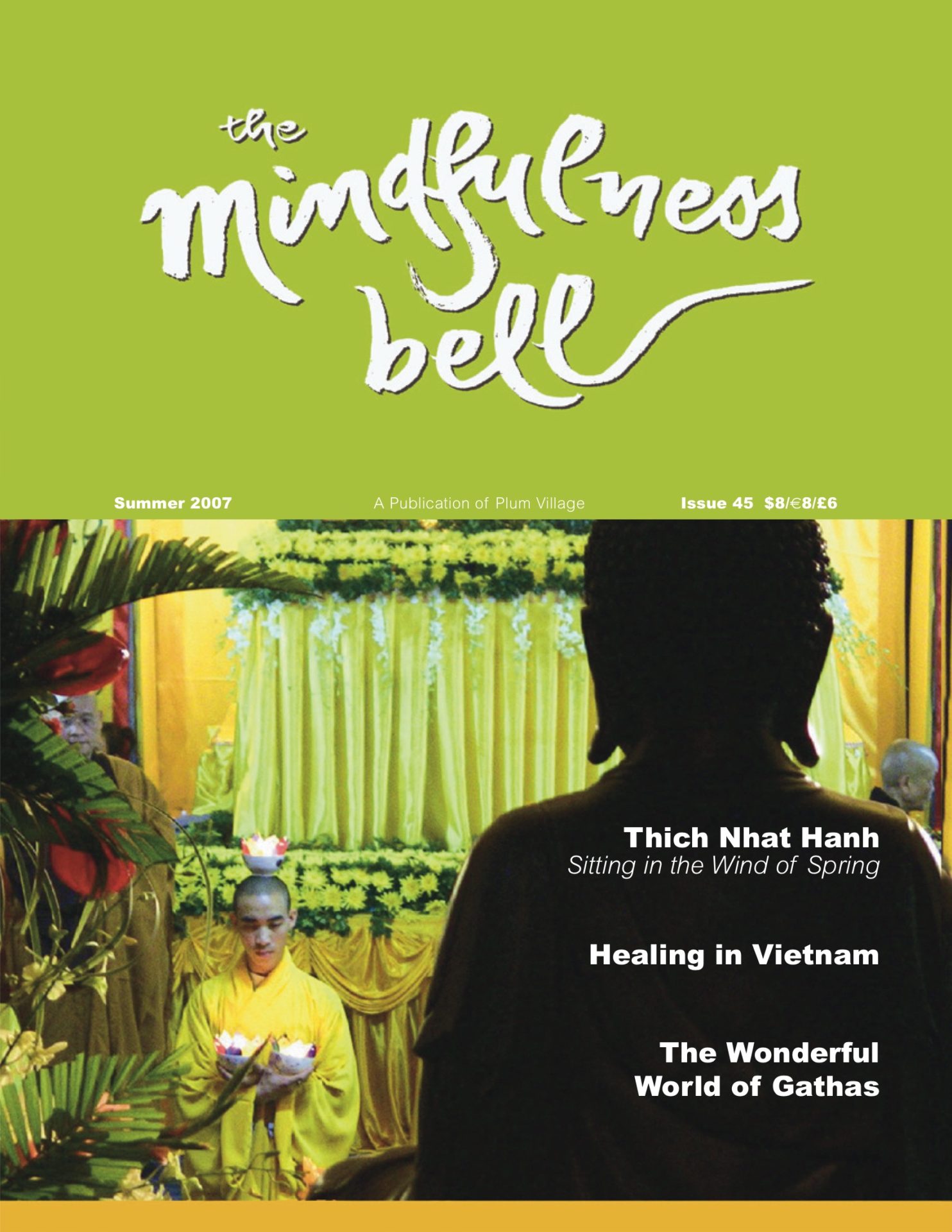By Sister Annabel,True Virtue
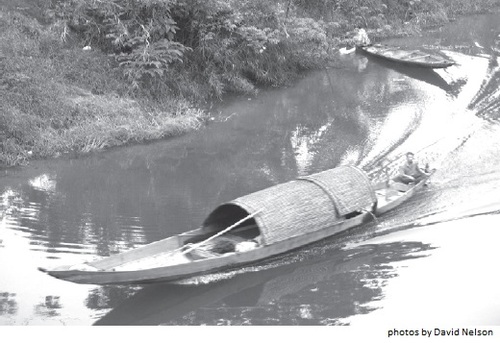
Sister Annabel has been a disciple of Thich Nhat Hanh since 1986; this is the fourth installment in her autobiography.
Walking and Relaxing
Plum Village emphasizes two aspects of the practice that Buddha Shakyamuni taught 2,500 years ago and that the descendants of the Buddha have continued to practice until now. They are mindful walking and relaxation.
By Sister Annabel,True Virtue

Sister Annabel has been a disciple of Thich Nhat Hanh since 1986; this is the fourth installment in her autobiography.
Walking and Relaxing
Plum Village emphasizes two aspects of the practice that Buddha Shakyamuni taught 2,500 years ago and that the descendants of the Buddha have continued to practice until now. They are mindful walking and relaxation. Some of the old-fashioned translations of the Pali suttas refer to the Buddha pacing up and down in the monastery. What we understand by this is walking meditation.
The Buddha Shakyamuni compared the Dharma to the ocean. Just as the ocean floor steps down gradually in shelves, so do the wonderful teachings and practices. First we hear the teachings, then we give thought to them, and then we practice them. As a teenager I saw a film about Sri Lanka. I saw for the first time a monk making the alms round. His walking made me feel peaceful and the image stayed with me, although I did not imagine myself walking that way.
Years later I was instructed to walk slowly by a Tibetan teacher. This teacher only knew one sentence in English that went: “Now we are walking slowly.” When a Tibetan nun who was in our party heard this, she would take hold of my hand so that I had no choice but to walk slowly. I had walked slowly in Piccadilly Circus thanks to this hand and on the Acropolis in Athens. Even amidst throngs of tourists our little party of Buddhist practitioners was able to wend its slow and relaxed way.
Go Very Gently
After that I went to India. It was not possible to walk in India the way I had walked in Europe. Just the collective consciousness and the heat made me walk more slowly. Being in India was like putting your car in a different gear — more slow and more relaxed. All the same I did not have in the continuum of my own mind the way to practice mindful walking. I walked more slowly but my mind was often searching and not at rest as I walked.
In Himachal Pradesh we had many little paths to walk on in the forest, carrying building materials, water, or firewood or just going from one place to another. It was very beautiful: there was the fragrance of the pine needles, the singing of the birds, the chanting from the monastery across the valley; the view of the rice fields down below and the towering snow-capped peaks above. The air was very clean and fresh. There were no roads nearer than eight kilometres. The paths were just for the walking of humans, cows, and the occasional horse with two sacks strung over its back. Sometimes the beauty of that place was enough to bring me into the wonderful present moment.
In India I appreciated above all that I could live in the spiritual environment of a monastery. I could appreciate what it meant to live more simply than I had experienced before in my life: no running water, no electricity, little to eat and sometimes cold but always the knowledge that the sun would come back and make us warm. The beauty of nature embraced and surrounded us and I felt safe.
Walking with the nuns in the forests I learned how to sing songs about meditation practice in Tibetan and when the sisters asked me to sing a meditation song in English, since I could not think of any, faute de mieux I had to make one up:
Go very gently, going nowhere,
Go very softly, stopping nowhere
Like a river deep and wide,
Always moving, still inside
This was inspired by the river at Tilokpur in Himachal Pradesh at the foot of the mountain on which the monastery stood. In the rainy season the sound of the rushing water would climb the mountainside and we could hear it day and night.
Touching Nirvana with the Body
There was one particular path that I walked on many times every day; as many times as we might go up and down the stairs in our house. This little path led the way from our hut to the building site where we were building a retreat center. It was my aspiration to walk this path as a meditation practice but I did not know how. So I tried to remind myself to keep my thinking very simple as I walked, but that was difficult because I was trying to practice with my mind without involving my body.
When I first met Thay and Sister True Emptiness [Sister Chan Khong] it was at the airport in London. Thay walked slowly in mindfulness. It was difficult for me not to overtake Thay without realizing it. Thay did not say anything and just enjoyed walking until we came to the car park. There Thay stopped and put a hand gently on the side of the car. This gesture alone helped my body and mind to come back together. I felt as if the hand of Thay were the mind and the car the body. In the excitement of Thay’s arrival I had forgotten all I had ever learned about slow walking.
Some days later when we came to the place where Thay was to lead the retreat, I still had the tendency to run everywhere. Thay asked me to go upstairs to check whether there was a room suitable for tea meditation. As I started out in haste to please Thay, Thay called me back and said very gently: “There is no need to hurry. You can go slowly.” As I walked up the stairs I tried to remember that; pulling each step reluctantly back into the present moment. After all I was someone who was used to going up and down stairs two steps at a time.
The beauty was the next day when Thay gave instruction on how to walk mindfully. Of course you have to involve your body. In any mindfulness or meditation practice your body practices along with your mind. Thay told us that the Buddha had said: “You can touch nirvana with your body.” You invest your whole person in mindful breathing, mindful footsteps, and the contact between the soles of your feet and the earth. Then you can touch nirvana with your feet on this planet earth. Even after we left the retreat Sister True Emptiness had to remind me to practice mindfulness as we walked on the street or in the railway station.
In 1989 Thay took his disciples from Plum Village on a pilgrimage to the Fleurs de Cactus meditation center in Paris and Thay’s former hermitage called Sweet Potatoes at Fontvannes in the forest of Ote. As we walked on the paths by the Marne River or in the fields around Sweet Potatoes, I began to feel that my steps could bring me back home. Steps alone could settle my mind and body and bring them back together again. I had watched Thay walking and my feet wanted to imitate that way. It was as if Thay had blessed my feet.
With the practice of mindfulness the miracle is in every step. Walking along the corridor of a residence hall or a hospital is as deep a practice as walking on a mountain path. Sometimes the steps come first and then the mindfulness and insight follow effortlessly. Sometimes the practice needs a little support from meditation words or conscious breathing for mindfulness to flow. As children we walk in paradise without anything to worry about or regret. The only thing is that we do not recognize we are walking in paradise. Using meditation words such as “arrived, home” can help us realize that we have arrived and we are at home. “Solid, free” gives a chance to recognize the solidity and freedom that mindful walking is bringing us so that we do not lose it.
It is surprising how relaxing walking can be. All of the four poses that we adopt in our daily life can be relaxing: sitting, standing, walking, or lying down. Life in Europe and North America is generally full of stress. In Asia, Africa, and South and Central America life is becoming more stressful. There is stress in the environment or the collective consciousness as well as stress in the individual body and mind. Stress is a major cause of ill-health or disease. The way our society is organized creates stress for the individual and the individual is causing society to be as it is. The way out is the practice of relaxation.
Total Relaxation
A favorite practice in Plum Village is total relaxation; relaxing the body from head to foot. When I was working as a schoolteacher, after work I came home and, before I did anything else, I lay on the floor to let go of all the difficulties the workday had left in me.
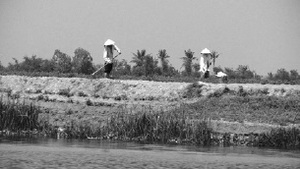
The main thing was to let go of perceptions and the unpleasant feelings associated with these perceptions. Since body and mind are inextricably interwoven, relaxing the body is immediately effective in relaxing the mind.
In the month of May 1989, during a retreat in the state of Virginia, I heard Thay lead the retreatants in guided total relaxation for the fi time. The relaxation stressed abdominal breathing and the lightness of our limbs as they relaxed like a piece of silk or duckweed floating on the water with the current. These images help us develop an attitude of non-resistance and effortlessness that is the ability to flow with what is happening. As the guidance ended, still lying down, we listened to a recording of waves breaking on the seashore. Sometimes Thay would read a poem of Thay’s in Vietnamese. It was never translated because the purpose was the musicality of the tonal language and the soothing rhythm of the verses.
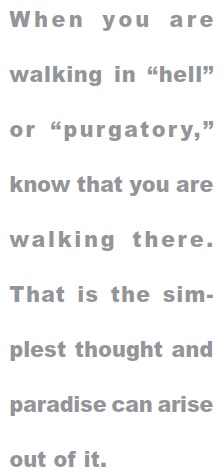
During the guided total relaxation an important instruction is to let go — let go of everything. I often use this practice of total surrender and acceptance when I am unwell and the practice of letting go in body and mind has an immediate effect of changing the situation for the better. When talking to someone who is sick in hospital, if we can help him or her let go, it can be very helpful.
The Determination to Relax
Walking and relaxation are experiences I enjoyed before I met the practice of mindfulness. So now do I have to make an effort to walk mindfully and to relax? It sounds like a contradiction to make an effort to relax. The practice lies in this: when you are not relaxed, know you are not relaxed. That is the simplest thought and relaxation can arise out of it. If not, take your thought a little bit further to know the causes for your not being relaxed and that will help remove the causes. When you are walking in “hell” or “purgatory,” know that you are walking there. That is the simplest thought and paradise can arise out of it.
When there is thinking that leads to fear and depression, know where the thinking is leading and you can come out of it without fear and depression. Just attention to breath or steps is wonderful. The Chinese word for thought, mind or intention is yi. In the word Anapanasati, sati or mindfulness is translated into Chinese as shouyi — holding or maintaining our mind. We hold our mind to our breath so that our mind does not need to wander into places of unnecessary suffering.
If someone is not able to sleep at night and she can practice total relaxation while lying awake, she can be refreshed and less tired the next day. As you lie in bed you can guide yourself or you can listen to a recording of a guided total relaxation so that you do not need to make any mental effort to remind yourself.
Relaxation, prashrabdhih, is one of the Seven Factors of Enlightenment, as is effort, virya. We need them both. There needs to be a certain determination to be relaxed and that determination can be called effort. Without the determination, habit energies of thinking make us tense. Equally important is the ability to be quiet and at ease in the situation that presents itself. After a while the practitioner is able to relax and the result is energy rather than effort. Effort and relaxation are not opposing forces; they are complementary. So when we know how to relax we have the energy to make effort.
This year in Vietnam, Thay is teaching relaxation as one of the essential practices of the Anapanasati Sutta (the Discourse on the Full Awareness of Breathing) where the exercise is: “breathing in I am aware of my whole body, breathing out I relax my body”. This is one of the most important practices I can do for myself and for everyone else at this time. When my body and mind are truly relaxed I have the freedom to be able to look deeply and see a little bit more of reality.
Nothing Is Wasted
Since I came to the practice of mindful walking and relaxation relatively late — I was 36 years old — I have sometimes asked myself whether I have not wasted a large part of my life. When I look deeply I see that no time has been wasted because now that I know how to practice mindfulness and concentration, I can make use of all that has happened — positive or negative. If I had this life again would I live it differently? To me that is just a hypothetical question. My blood ancestors needed to go through this with me. How could I force them to do it differently? They laid the bridges and asked me to continue, without looking back. They wish for me to take them forward in a different direction but always building on what had gone before, taking that as the essence, not as good or bad.
So the practice in India was necessary. Without it the practice in Plum Village would not have been possible. As I walked on the little forest paths carrying building materials, I was always asking myself: How can I make this a spiritual practice? It took time for the question to be answered. It took another ten years to come to Plum Village.
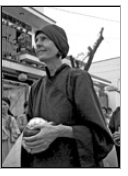
Sister Annabel, Chan Duc, True Virtue, became a Dharma teacher in 1990 and was Director of Practice at Plum Village for many years. Since 1998 she has been abbess at the Green Mountain Dharma Center in Vermont.

